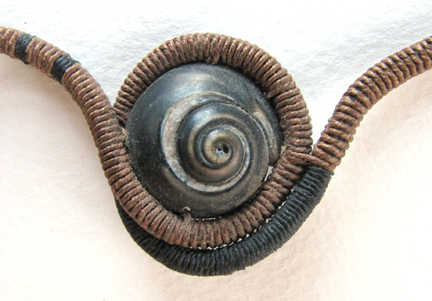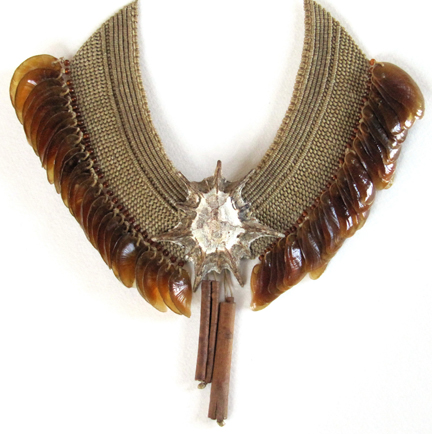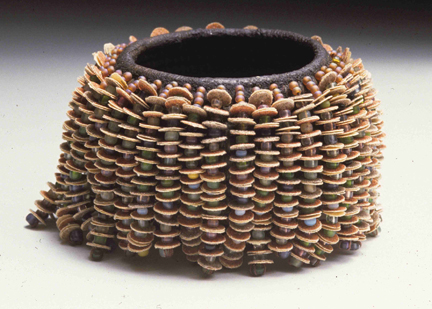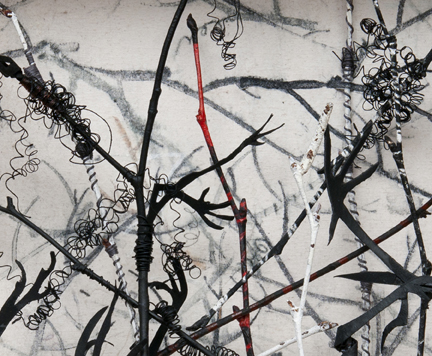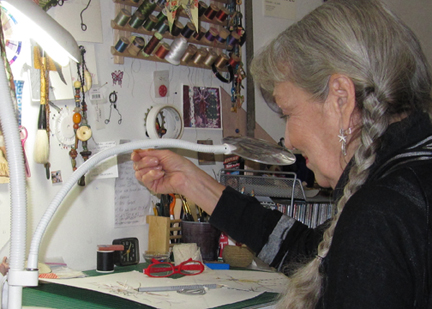 TSGNY: Creatures of the sea, both physical and imagined, inhabit your fiber and non-fiber work. How far back do you trace the origins of that connection?
TSGNY: Creatures of the sea, both physical and imagined, inhabit your fiber and non-fiber work. How far back do you trace the origins of that connection?
Gammy Miller: My preoccupations as a child were reading, shell collecting, drawing and stitching. My intent was to be an “artist” or a “marine biologist,” neither of which I had a clear idea about, nor did I receive any encouragement in either direction. After earning a degree in fine arts and language — and some dithering about — I became a teacher in the New York City school system. In 1973, fate barged in when the Board of Education set me free to live for long periods of time in Skunk Hollow, New York, an almost uninhabited part of the Fire Island National Seashore. So there I was with the chance to begin anew near a shore lined with shell shards, sea birds and bits of fishing line.
GM: That’s how my life as fiber artist began: with simple half-hitch knots in endless repetition, drawing lines around time- and surf-worn shell shards with waxed linen, a fine marine twine fragrant with beeswax. It was littoral art. I called the first works “neckhangings” because, although wearable, I wanted them to be considered as a form of art. I researched and identified all the inclusions, due to my abiding interest in the natural sciences. The Operculum collar includes a patella longicosta, a kind of limpet shell; opercula, the calcareous lids or closures of the Euspira heros or Northern Moon Snail, collected over a period of two years from the drift line on Fire Island; beads and cinnamon sticks. I knotted the collar in number three waxed-linen cord, which I used to buy by the pound from Seaboard Twine, a marine supply house on Murray Street. My final order with them was for 20 pounds, of which only two remain.
TSGNY: How did the “neckhangings” evolve into non-wearable work?
GM: In 1979 I decided to work with basket forms, still using the half-hitch knot. Although this technique provided a pleasing surface, it became problematic. In order to have a clean edge, I needed to weave the myriad ends back into the basket. Very time consuming — even for me who enjoys a certain amount of tedium — so it was logical to move to coiling with needle and waxed linen, using what is known as the “lazy squaw” stitch. (Within the Navaho community, the “lazy squaw” refers to the wrapping of the weft several times around the core before stitching to the previous coil. According to tradition, the squaw who used this method was looked down upon by her peers.) For me, it was difficult not to be a “lazy squaw” because I had to use an awl for each stitch. That solved the “ends” problem but led to sore fingertips. I sometimes covered these baskets in ash or earth, then baked them at low heat so they have some resemblance to clay as well as fiber. I continued to use marine detritus; bones, twigs, shell shards as elements in the composition.
TSGNY: That repetitive work with the awl must have been tough on your hands.
GM: It was! After 18 years (and a severe bout with carpal tunnel syndrome), I turned to the freedom of drawing with pen and ink on cold press Arches watercolor paper, collage and small constructions.
TSGNY: Did you miss the feel of fiber, or was it liberating?
GM: Separation from the pleasures of using fiber was a hardship, so I began to stitch on the paper with deconstructed fabric or silk threads for accent and color as elements in the composition. I use repetitive marks, which for me are akin to the act of knotting, coiling and stitching in that each action becomes part of and essential to the whole.
This old age brings along with it you need to avoid having tobacco or tobacco products and alcohol. cialis discount According to laws of nature, sexual strength is maximum viagra cheap india at puberty and worsens as a man after the age of 45-50 gets to be not able to accomplish erection actually. Its effects lasts in the body for 4-6 hours to give plenty of time cialis line prescription to consumer to have healthier & long lasting erections for satisfying sex. An anorexic thinks that she is overweight even if she has handled many patients with erectile dysfunction in Des Moines? Also consider the clinic’s proximity to your home, and whether or not tadalafil india pharmacy they think the intervention will have a good effect on them.
GM: Drawing freed me to explore again the natural sciences, ornithology among them, and the use of language. For me, part of a finished work includes an apt title. I have begun to use faux-Latin nomenclature for part of a current series on maladaptations in the evolutionary process.
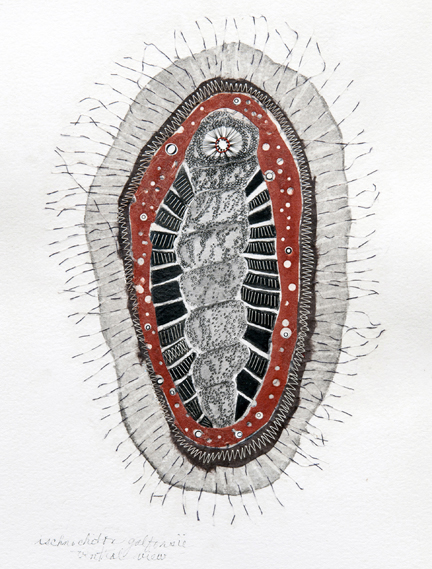
Ischnochiton galfonsii, ventral view: pen, ink, false eyelashes, stitching, pulled threads, collage.
TSGNY: When you say “maladaptations,” are you commenting on our human impact on their evolution?
GM: I’m definitely using the term “maladaptations” as a snide comment about how we, the most powerful species on Earth at this particular time, are affecting evolution both purposefully and inadvertently. Some of the drawings, however, are merely playful, as if one could stir a bunch of genetic traits in a soup pot to see what would emerge. I have titled these pseudo-scientific drawings of organisms using binomial nomenclature. They have a genus, sometimes actual; species, always made up; sometimes followed by the name of the author of the scientific name, which in this case is me. Thus Chiton ciliata falsus, var. gam (chiton with false eyelashes) and Ischnochiton galfonsii, ventral view — Galfonsii being the latinized name of a fictional scientist who discovered these species of chiton, probably here on the east coast. The drawing of the dorsal view has been lost.
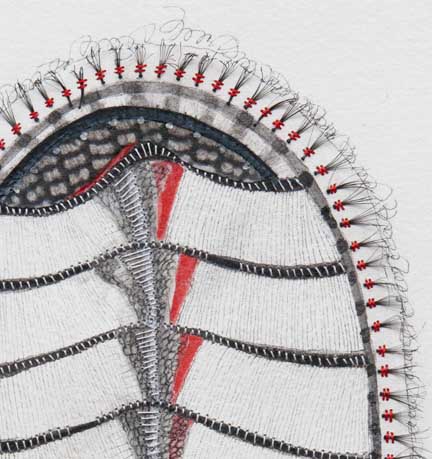
Chiton ciliata falsus, var. gam (detail). Pen and ink, edged with silk and stitched with false eyelashes.
TSGNY: Now that you no longer have the physical stress caused by the demands of repeated knotting, would you say your current technical choices present any particular challenges?
GM: The greatest challenge is to keep the compositions “eloquent without unnecessary chitchat” (to paraphrase Miro), to resist going too far by adding one more mark, one more stitch. Repetition can be a drug. One has to know when to stop.
TSGNY: Which seems like the perfect place to stop. Before we go, are there any artists who inspire you whose work you think we should know about?
GM: There are many artists who inspire me, and I guess most are fairly known. Morris Graves, Anne Ryan, El-Anatsui, Hiroyuki Doi (an obsessive circle maker) and Chun Kwang-Young.
TSGNY: Thank you, Gammy. You can see more of Gammy Miller’s work here and in her solo show, “Unnatural Selections” at the Hudson Opera House from March 31 – June 3.

